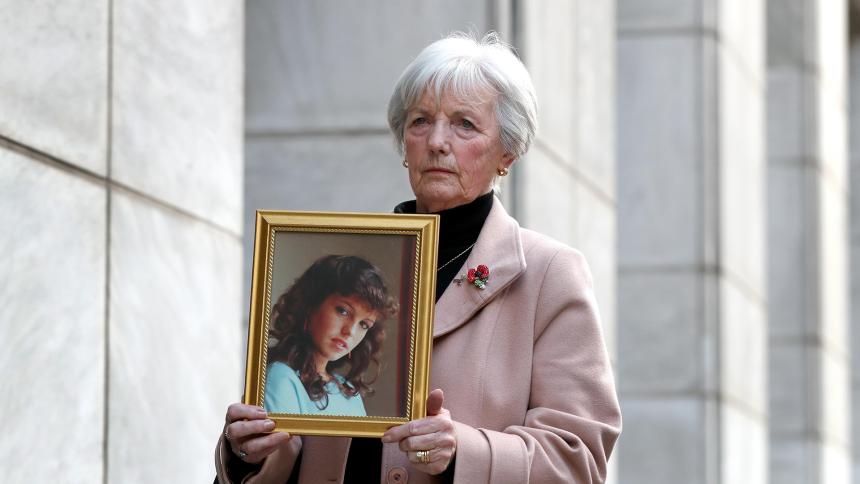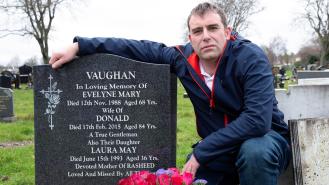
12 British killers convicted without a body
Killed Without A Trace explores the huge task facing police forces and prosecutors across the UK as they try to get justice for families and prove a murder has happened without that vital piece of evidence – the body. The show airs Mondays at 9pm on Crime+Investigation.
Contrary to what some might believe, it’s possible to be convicted of murder even if a body is never found – as these killers found out to their cost.
1. Mark Brown
When labourer Mark Brown was put away for life in 2023, it was the culmination of a grim double murder investigation where the body of one victim – Leah Ware – was never found.
Brown had first met Leah back in 2018 when he’d hired her through the website AdultWork. Their relationship progressed to the point where Leah – a drug user with mental health issues – moved into a shipping container Brown was renting on the remote Little Bridge Farm, Hastings. It was a sadomasochistic relationship which became ever more intense, until Leah mysteriously disappeared in May 2021.
Later that year, Brown used AdultWork to hire Alexandra Morgan and lured her to the farm on the pretext of an escorting job worth £100,000. Following her disappearance, CCTV footage of Alexandra’s vehicle led detectives to the farm, and fragments of her incinerated body were later discovered in an oil barrel.
The whereabouts of Leah’s remains are still a mystery, and during his trial, Brown stubbornly maintained that she was still alive. Jurors weren’t buying it – especially given the revelation that, soon after Leah’s disappearance, he’d messaged a friend saying that he had been ‘disposing’ of something using an old oil drum and five litres of diesel and that he was haunted by the terrible things he’d done. ‘A psychopath with a conscience,’ he said of himself. ‘It's a joke really.’
2. Ian Simms
One stormy February evening in 1988, a young woman named Helen McCourt got off a bus in the village of Billinge, Merseyside. The bus stop wasn’t far from her house, and Helen – returning from the insurance office where she worked – was keen to get back quickly because she had a date with her boyfriend.
But Helen vanished during this short walk, leading thousands of villagers to comb the fields and woods for any signs of what had happened to her. The breakthrough came when a witness reported they’d heard screaming coming from a local pub close to the bus stop. It transpired that the pub landlord, Ian Simms, had had a row with Helen just days before, and investigators soon uncovered plenty of grisly forensic evidence tying him to the case, including spots of Helen’s blood on his car and in his flat.
Despite the lack of a body, Simms was found guilty of her murder, making this one of the first convictions which rested almost entirely on DNA fingerprinting. He was released in 2020 after serving 32 years in prison and died two years later having never revealed what he’d done with Helen’s body.
Helen’s mother, Marie, was made an MBE in 2022 in recognition of her campaigning work which led to the creation of Helen’s Law – legislation which makes it more likely that criminals who hold back information on their victims will be denied parole.
3. Mark Bridger
The murder of five-year-old April Jones in October 2012 didn’t just rock the small community of Machynlleth, Wales, it became a major news story, with images of the little girl suddenly known to millions across the world.
Last seen getting into a 4x4 while out playing with friends, April was the subject of the largest manhunt in the history of British police. Yet it only took hours for detectives to zero in on a prime suspect: Mark Bridger, a well-known local man who often claimed to be a former mercenary and SAS soldier.
In fact, he was an alcoholic fantasist who had previously tried to groom April’s older sister on Facebook, and who was hooked on child pornography. Forensic analysis revealed that fragments of human bone were in the fireplace of his cottage, and blood matching April’s DNA was also found.
Despite the damning evidence, Bridger pleaded not guilty, claiming that he’d accidentally run April over in his car and couldn’t remember where he’d left her body due to having been in an alcoholic stupor. The jury didn’t believe this story and he was sentenced to a whole life order.
4. Peter Reyn-Bardt
One of the most remarkable murder convictions without a body occurred back in 1983 when airline employee Peter Reyn-Bardt was sent down for the killing of his estranged wife, Malika de Fernandez, which occurred more than two decades prior.
Reyn-Bardt had dismembered and buried Malika on the edge of Lindow Moss, a peat bog in Cheshire. Although police searched his property for traces of the missing woman, the lack of any evidence or body meant Reyn-Bardt had seemingly gotten away with the crime.
Then, in 1983, labourers in Lindow Moss dug up a human head so well preserved that it still had remnants of the brain and eyes attached. Police assumed it was evidence of a murder – most likely, the cold case killing of Malika de Fernandez.
When questioned about the discovery, Reyn-Bardt quickly cracked and admitted he’d murdered his wife, saying, ‘It’s been so long, I thought I would never be found out.’ But then carbon dating revealed that the head, far from belonging to Malika, actually dated back to Roman Britain and owed its uncanny preservation to the chemical effects of the peat bog.
On hearing the news, a mortified Reyn-Bardt attempted to retract his confession but it was too late – he was convicted of murder and spent the rest of his life in jail. The remains of his wife have never been found.
5. Hassan Al-Shatanawi
After reporting his wife’s disappearance in July 1993, Hassan Al-Shatanawi gave the impression of a desperately worried husband. But hidden behind the façade was the mind of a cold and calculating killer.
It had been over a month since Laura May’s disappearance before Al-Shatanawi had reported her missing. It was enough time, he believed, to cover his tracks and get away with a brutal murder.
But his plan unravelled after selling the garden shed in which he had killed her. Shortly after her murder, Al-Shatanawi ordered a joiner to remove the shed from his allotment and burn it. The joiner refused and sold it to a friend instead of destroying it.
A month later, the tradesman who bought the shed recognised Al-Shatanawi when he appeared in newspapers and on television pleading for his wife’s safe return. The tradesman contacted the police, the shed was traced, and Al-Shatanawi’s secret was uncovered.
The floor of the shed had been partly gouged and covered in creosote, but forensic experts recovered four hairs from Laura May’s scalp and several spots of blood.
Despite protesting his innocence, Al-Shatanawi was found guilty of murder and jailed for life in October 1994. He was released from prison and deported back to his home country of Jordan in January 2013.
The body of Laura May, a 36-year-old mother, was never found. Her family has vowed to keep searching for her remains.
6. Ahmed Al-Khatib
Ahmed Al-Khatib devised a chilling plan to lure his estranged wife, Rania Alayed, into a final confrontation that would end in her murder. On 7th June 2013, Rania, a young mother of three, dropped her children off at her brother-in-law’s flat in Salford, Manchester. Just minutes later, she was dead.
Rania’s murder was not just a result of violence – but it had been meticulously and chillingly planned in advance to silence her forever. After killing her, Al-Khatib attempted an elaborate ruse. He left the property wearing her headscarf and jeans, giving the impression she was still alive. Behind him, in a suitcase, he carried his former wife’s lifeless body.
In a series of calculated moves, Al-Khatib transported Rania’s body to North Yorkshire. He buried her somewhere along the A19, a remote area where authorities would struggle to locate her remains. Her body remains lost to this day.
During his trial, Al-Khatib spun a series of disturbing lies. He claimed Rania had appeared to him as a djinn – an evil spirit in Islamic folklore – and attacked him. But the jury saw through his claims after hearing that Rania had been trying to escape from years of domestic abuse. Shortly before her death, she had contacted police and a solicitor, seeking protection as she tried to build a new life.
7. Kevin Doherty
For nearly two decades, Kevin Doherty harboured a sinister secret. In 1995, his lover Jane Harrison vanished without a trace just days before they were due to take a holiday together.
Doherty, then a married man, had killed the 32-year-old mother-of-two and concealed her body. He maintained the lie for the next 18 years – claiming that Jane had simply gone off with another man. He kept this deception with the police, Jane’s family, and even his own family, allowing him to evade justice.
But the cracks in Doherty’s story had begun to show just hours after Jane’s disappearance. He returned to his flat looking 'sweaty and panicky', telling Jane’s babysitter that he’d spoken to her and she would return soon. These phone calls were fake – they had come from his own mobile as he tried to manufacture an alibi.
For years, investigators had only circumstantial evidence linking Doherty to Jane’s death. But in 2013, after a renewed investigation, Doherty was arrested and brought to trial. Although the jury couldn’t convict him of murder, they found him guilty of manslaughter.
Sentenced to 12 years, Doherty still refused to reveal the whereabouts of Jane’s remains.
8. Alan Edwards
Alan Edwards’ relationship with Susan Waring was a nightmare from the start. Described as a 'violent bully', Edwards subjected Susan – a vulnerable woman with health problems and learning difficulties – to a brutal cycle of control and abuse. Their relationship quickly became turbulent, marked by both verbal abuse and physical violence.
Neighbours often heard Edwards calling the mother-of-five 'stupid' and 'a dumb baby', and even witnessed him punching her just weeks before her disappearance. She was last seen alive shopping with her abuser on 29th January 2019. The following day, Edwards claimed he kissed her goodbye outside his flat, but she was never seen again.
After Susan's mother reported her missing, investigators searched Edwards’ flat. They found blood on the walls and over 100 blood spots in the lounge. Disturbingly, Susan’s DNA was also found on a skull mask Edwards allegedly wore as he attacked her at close range.
During his trial, it emerged that Edwards had a history of violence against women. Despite his claims of innocence, the jury needed only 90 minutes to convict him of murder. A detective who led the investigation into Susan’s death has vowed to never give up on finding her body.
9. Ben Lacomba
In October 2018, 46-year-old Sarah Wellgreen disappeared from her home in Kent sparking a massive police search. The subsequent hunt for the mother of three was one of the largest in the history of Kent police with 1,275 areas and 2,782 miles covered.
Suspicion for the disappearance soon fell on her ex-partner and father to her children, Ben Lacomba. During his subsequent trial for murder in 2019, the court heard that the two had met online in 2004. However, by the time of Sarah’s disappearance, the relationship had been marred by tensions and problems.
The two had initially split up in 2014 but continued to live together. Sarah was in the process of obtaining a mortgage to buy Lacomba out of the property.
At his trial, Lacomba denied responsibility for Sarah’s disappearance and claimed that he was asleep on the night she vanished. But evidence shown to jurors revealed that he had switched off a CCTV system in the middle of the night and parked his car in an unusual spot to evade detection.
Despite being sentenced to 27 years behind bars, Lacomba failed to reveal where Sarah’s body was located. To this day, it has not been found – and the manner of her death has never been determined.
10. Scott Walker
On 21st July 2020, 17-year-old photography student Bernadette Walker was reported missing by her mother, Sarah and stepfather, Scott. She had last been seen alive three days earlier leaving her grandparents' house in Peterborough.
Days before her disappearance, Bernadette had made allegations to her mother that her stepfather had been sexually abusing her for several years.
When a rucksack containing her diary was found during a search of a lock-up garage, police discovered that she’d written about telling her mum about the abuse. 'Told my mum about my dad and the abuse. She called me a liar and threatened to kill me if I told the police. What kind of parent wouldn’t believe their daughter?' she’d written on 16th July.
During his trial for murder at Cambridge Crown Court, the jury heard that Scott had likely strangled Bernadette to prevent her from pursuing allegations of sexual abuse any further. He refused to disclose the whereabouts of Bernadette’s body.
After the murder, Scott conspired with Bernadette’s mother to cover up her death. They sent messages from her phone to friends to give the impression she was still alive. Police continued the search for Bernadette’s body for several weeks using dogs, diving equipment and drones, but nothing was found.
Scott Walker was given a life sentence in July 2021 and told to serve a minimum of 32 years in prison. He died behind bars in 2023. Bernadette’s mother was also convicted of perverting the course of justice and sentenced to six years.
11. Mark Moodie
On 5th December 2022, 24-year-old Maureen Gitau made the fateful decision to leave her aunt’s birthday party in Deptford, London, to meet Mark Moodie. Moodie, who was known to her, worked as a caretaker at nearby premises.
CCTV footage from Richmond House later revealed the pair entering the building, but Maureen was never seen alive again. Moodie was caught on camera moving a large communal waste bin in the basement, which prosecutors believed contained her body. After being taken to a waste processing plant, it was likely incinerated.
Despite a massive search involving 125 trucks and 20,000 hours of police time, Maureen’s body was never recovered. Moodie denied any involvement in her disappearance but was convicted of her murder at Woolwich Crown Court and sentenced to life in prison with a minimum term of 20 years.
While Moodie never admitted guilt, the evidence against him – including CCTV footage and actions to cover up the crime – was overwhelming.
12. George 'Kenny' Metcalff
In November 2017, 46-year-old Patricia Henry vanished from her flat in Girvan, South Ayrshire. The last person to see her alive was George Metcalff, a 71-year-old man who had exerted control over her life for many years.
Patricia, a vulnerable woman who had issues with alcohol, had come to depend on Metcalff for financial help. The pair briefly lived together in Renfrewshire, before Metcalff arranged Patricia’s move to a flat in Girvan and became her guarantor.
Shortly after her move into her new flat, Metcalff hired a van – which police believed was used to dispose of her body. She was not reported missing until January 2018.
Despite no body ever being found, police gathered a damning amount of evidence. Witnesses reported Patricia’s growing distress before she disappeared, including an emergency call to a neighbour just before she was last seen.
Friends and family recalled that Patricia had accused Metcalff of sexual assault. However, she remained financially dependent on him, a situation that detectives described as coercive control.
The case against Metcalff was aided by his long history of violence against women, with other victims coming forward to detail the abuse they suffered at his hands. Metcalff was convicted of Patricia’s murder, alongside charges of rape and assault involving other victims dating back to 1971. He was sentenced to life imprisonment with a minimum term of 22 years and died behind bars in September 2024.
Patricia’s daughter, Alannah, pleaded with Metcalff to reveal where he had hidden her mother’s body, but he has never confessed, leaving the family without closure.















